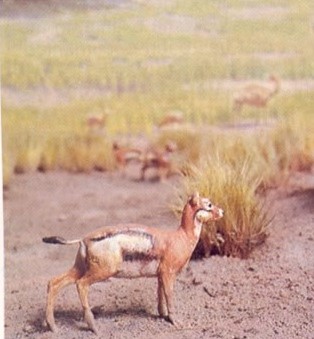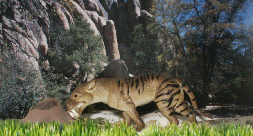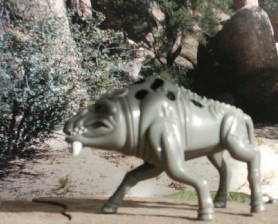
From the
Dinosaur Collector
The Oligocene
was the third epoch of the Tertiary period. It lasted from about 33.7 to 23.8 million years ago The climate remained tropical to subtropical but with a cooling trend prevalent throughout the period. Brontotheriums die at the end of the Eocene. There is exchange of animals among northern continents, as evidenced by the similarity in vertebrate faunas. Amphicyonids, canids, camels, tayassuids, protoceratids, and anthracotheres appear. The appearance of the first elephants with trunks, early horses, and the spread of grass that would produce vast plains in the following epoch, the Miocene. Grass now seems have been present in the Late Cretaceous of the southern continents but not wide spread. The "bulk feeding" in the open grasslands and savannas results in the increase of general herbivore size. Ungulates continued to get larger throughout the Oligocene period. See Walking with Prehistoric Beasts "Land of Giants" 25 Million Years Ago set in the Late Oligocene Mongolia.
UPDATED 10/1/08
Indricotherium,Baluchitherium. or Paraceratherium are names applied to the giant relatives of the rhino. Discovery channel has used all 3 names for programs. Walking with Prehistoric Beasts features (WWPB) has Indricotherium as a solitary giant living in a relatively arid environment. While the PaleoWorld does a Paraceratherium program which seems to be the name with priority. Recently a program on a french expeditions excavation in Pakistan uses Baluchitherium. There the environment was reconstructed a lush jungle. The excavation of what appears to a herd that drown crossing a river seems to indicate a social herd animal. The later desiccation as India collided with Asia probably reduced the food supply such a large animal needed. Indricotherium was the largest land mammal ever to live. This short lived group of rhinoceros lived in Central Asia and China. It was 27ft long as big as some of the extinct sauropods
 |
||
Indricotherium from Nabisco. |
Starlux Baluchitherium. |
The saber toothed cat is repeating theme in evolution.
Various saber and dirk toothed cats have developed to take advantage
of large prey without being directly related. Eusmilus
a false saber toothed cat lived from the end of the Eocene until the Oligocene.
It was about the size of a leopard and lived in North America. |
Leptomeryx, a small relative of the modern mouse deer lived from in North America. It lived it social groups much like modern small antelopes. | |
 |
||
Eusmilus from Bullyland.
|
From Royal Saskatchewan Museum in Regina, Saskatchewan
diorama. Picture by Sean Bell |
The creodonts were the dominant predators of the Eocene. It has been proposed that creodonts and marsupials are descended from a common non-placental stock. Hyaenodon was a long lived and wide spread group. They ranged in size from a weasel to a hyena. However, their diversity quickly declined after the appearance of more modern Carnivora in the late Eocene, and the last creodonts go extinct in the late Miocene. Some creodonts lived in arctic and sub arctic habitats it is possible that from such types are derived the true seals, or Phocidae. They may also have given rise to modern carnivores instead of being an evolutionary dead end.
 |
||
| PlayVision Hyaenodon from the large mammal set. This set is now getting hard to find. The figure is mislabeled as a Hyena, a modern member of the carnivore family to which it is only distantly related. Labeling was a problem with the entire series. | AAA medium Hyaenodon. From Toyosaurus. This is a Walking with Prehistoric Beasts look alike. |
There are two types of chalicothere - this kind shambled along with most of their weight on their short but strong hind legs. The long front legs had enormously long, curved claws which meant the chalicothere couldn't put its font feet flat on the ground, and instead had to walk on its knuckles. These chalicotheres had no front teeth in the upper jaw, and even the back teeth show little wear from use, and so they must have been fussy eaters - picking only the newest, freshest shoots and putting them straight into the back of their mouths like modern pandas. Fossils of a knuckle-walking chalicothere called Chalicotherium (pebble beast) are found in the Late Oligocene of Asia, but fossils are rare. Knuckle walkers are thought to have evolved in Asia much earlier.

Chalicotherium from Bullyland. This animals was so obscure that many retailers mistook the animal for a sloth.
There are at least five genera of Entelodonts: Archaeotherium, Megachoerus, Dinohyus, Entelodon and Eoentelodon. Entelodonts represent an extinct family related to pigs known from North America, Europe and Asia. They ranged in size from a large dog to a large buffalo, and probably averaged cow sized. In North America, the family ranged from the Late Eocene to the Early Miocene, or about 39 to 16 million years ago. Entelodon (perfect toothed) is the best known of the family thanks to the BBC Walking with Prehistoric Beasts program. They were large omnivorous animals with nasty dispositions. Skulls with bites matching that of Enteldon show they engaged in intra species combat.
 |
 |
|
| Silver Dolphin Entelodon from their WWPB activity book. |
Return to Cenozoic menu
 Click on the Site A
icon to the right for Dioramas organized by period or by manufacturer.
Click on the Site A
icon to the right for Dioramas organized by period or by manufacturer.